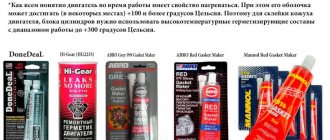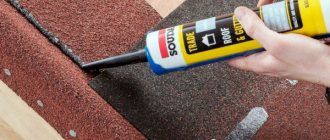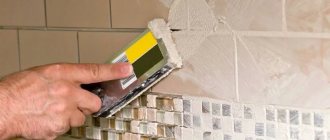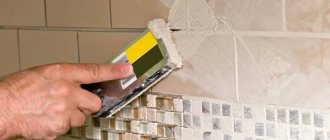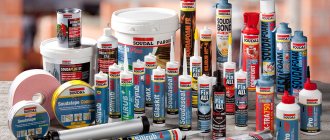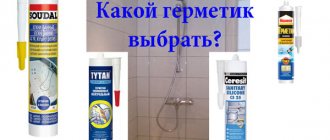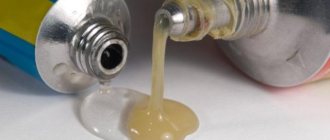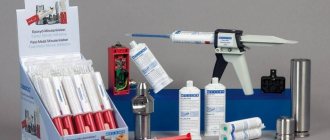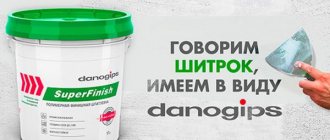What should you consider when choosing?
There are many types of tile grout. When choosing, you should pay attention to the following characteristics:
- water resistance;
- degree of shrinkage;
- level of adhesion to the base;
- service life;
- color.
The material must be resistant to water. Some types of professional grout can be used for swimming pools. With a high degree of shrinkage, cracks may form, which in turn will shorten the service life of the tile covering.
It is important that the degree of adhesion of materials is as high as possible. The packaging also indicates the maximum service life of the grout. It is best to give preference to compounds that can withstand both high and low temperatures. The grouting agent should repel water.
When choosing, it is important to pay attention to the color scheme of the grout material. Color is needed to organically complement the tiles.
Varieties of compositions suitable for use in the bathroom
The “sealants” category includes a large number of different compounds, the main purpose of which is to insulate seams and joints. They are made from polymers and various modifying additives. It is worth considering that not all sealants are intended for use in rooms with high levels of humidity. The most commonly used compositions are:
- Based on silicone, which in turn are divided into neutral and acidic;
- Polyurethane;
- Acrylic;
- With acrylic+silicone base.
The most common is considered to be a composition based on fungicides. This is a silicone sealant that allows you to easily seal joints between walls and fasteners, plumbing equipment, as well as seal new seams and update old ones.
Advice!
A neutral silicone-based sealant should be chosen for metal bathtubs. Acrylic sealants are best suited for bathtubs made of a similar material due to the similarity in composition.
Grout colors
In most cases, manufacturers rely on basic shades. The most commonly used grout colors are:
- white;
- black;
- green;
- dark brown;
- blue.
There are transparent silicone grouts with antifungal properties. If you don’t have a suitable tone, you can purchase several different colors and mix them.
To get the most uniform surface possible, the grout should match the color of the tile.
You can create a more unusual interior using contrasting grout.
For more information about grout colors, read the article - How to choose grout for tiles by color: secrets that only a few know
How to choose grout for tiles
Mixtures for tile joints differ in price, application technique, and service life. When going to the store, the master must know which grout to choose for the tiles in the bathroom, on the floor in the hallway. To choose the right material, you need to know the width of the seam and the color of the finishing material. The choice will be influenced by the humidity level in the room in which the ceramics are being laid. The main characteristics of the fugue depend on the main component of the mixture. Only by comparing all these factors can you buy a filler that will last 15-20 years without requiring regular updating.
Purpose
Wall tiles are subject to minor wear. Floor materials are under constant abrasive influence. Grout manufacturers take this into account when indicating the purpose of the product in their recommendations. Ceramics is the main material for finishing rooms with high and high humidity. Mixtures that can withstand constant, long-term contact with water differ in their characteristics from fugues that are periodically wiped with a wet cloth. For a swimming pool, you cannot purchase a puffer intended for use in rooms with high humidity.
Ceramics are used for cladding building facades and plinths. Materials used outdoors are highly frost-resistant and can withstand sudden temperature changes. The fugue, which is intended for interior work, cannot be used on an open terrace or entrance area.
Mixture base
Products are divided into three main groups, depending on the base component, which can be cement, epoxy resin, or silicone. The base affects the main performance characteristics: water resistance, strength, elasticity, service life. Epoxy resins provide strength and resistance to mechanical and chemical stress. The compositions on their bases can have dozens of different shades, and their service life exceeds 20 years. The disadvantages are the high price and complexity of the work. An inexperienced master may not be able to handle the mixing. An error in proportion will result in loss of quality. You need to work with epoxy compounds carefully: you will have to use expensive specialized products to clean ceramics.
Cement-based moisture-resistant grout for tile joints has a low price - 5-7 times lower than compositions based on epoxy resins. This is the best option for renovations in a city apartment or country house. The material is inferior in service life and strength to epoxy compounds, but is distinguished by high working comfort and a good selection of shades.
Silicone grouts are specialized and recommended for sealing gaps between walls, bathtubs, sinks, and plumbing equipment. You need to work with the material carefully; correcting mistakes is difficult - you can break the structure.
Seam width
This indicator must comply with the recommendations of fugue manufacturers. If the expansion gap is 10 mm, and the fugue is intended for seams no more than 5-6 mm wide, then cracks will inevitably form after drying. This will cause the aggregate to collapse and water to penetrate inside.
Ceramic tile factories today offer products in different formats. The classic size of 20x20 cm, for which the compensation gap did not exceed 5 mm, is not the most popular today. The width of the seam is determined by the format of the tile and the layout of the surface that is covered with ceramics. Dimensions can reach 3-4 cm; you can check them in advance with the tilers. The information will help you choose the right material and calculate exactly its quantity.
Moisture resistance
Constant exposure to moisture negatively affects any material. When finishing a pool bowl, a shower room in an enterprise or fitness center, or a façade, it is necessary to use a waterproof fugue. Belonging to this category must be indicated by the manufacturer on the packaging. After hardening, the filler withstands constant contact with water, shower jets and rain streams. The grout is not washed out or destroyed throughout its entire service life. This category includes epoxy compounds, cement fugues with water-repellent additives.
Moisture-resistant compounds are used in rooms with high humidity. These are bathrooms, bathrooms where showers are rarely used, and a kitchen. The characteristics of the fugue allow it to withstand regular wet cleaning. This category of finishing materials includes standard cement and silicone grouts.
Color
How to choose grout for tiles with a bright, rich color? The answer to this question does not cause much trouble for designers today. Manufacturers produce fugues in different shades. A classic solution - white color will suit any finishing material. An alternative is a contrasting grout, which can emphasize the ideal geometry of tile laying. If mistakes were made during finishing work, then it is better to use a fugue of the same tone with the base shade of the ceramics. This will help hide errors.
For white tiles, you can choose any shade that will harmoniously combine with the overall color scheme of the room. If you want to diversify the interior and make the project individual, use a grout that is 1-2 tones different from the color of the ceramics. It is difficult to imagine exclusive solutions without metallized or pearlescent compositions, mixtures with inclusions of decorative particles.
The best manufacturers
There are both domestic and foreign manufacturers of tile grout on the market. The quality of such materials is almost the same, the difference lies in the price of the products. Well-known manufacturers:
- Plitonite;
- Ceresit;
- Atlas.
Plitonite
Plitonit is a Russian-German manufacturer. Grouts from this company are excellent for sealing joints from 2 to 6 mm. There is a special grout material for floor tiles.
It is characterized by greater fluidity, which allows you to quickly fill seams without the formation of voids.
Grouts from the Plitonit company contain solid components that make the material more wear-resistant and resistant to aggressive environments.
The company has also developed special grouts that have increased waterproofing properties. Due to the presence of biocidal additives, grouts repel dirt well. They are suitable for filling joints from 2 to 20 mm.
Ceresit
Ceresit products are very popular. Such grouts tolerate high humidity and temperature changes well.
They have water-repellent and antifungal properties.
Some types of grout from Ceresit can be used for outdoor work, as they tolerate frost well.
The products of this company combine high quality and affordable prices.
Atlas
Atlas is a Polish production that produces 2 types of grout mixtures. The first type is intended for grouting joints of 1-6 mm, and the second for 4-16 mm. The material has good adhesion and withstands mechanical stress.
Atlas grouts are suitable for use in damp environments. The color range is quite wide.
The grouting material from a Polish manufacturer is highly elastic and can withstand temperature changes.
Can be used both for interior spaces and facades.
Using sealant
The most typical applications for sealants in the bathroom include the following:
- Sealing the joint between the wall and the shower partition or filling the seam between the tiles and the bathtub. When a water jet hits an untreated joint, puddles often appear on the floor.
- Grouting tile joints. In most cases, for these purposes it is recommended to choose a color composition similar to the shade of the tile. Many well-known manufacturers of polymer compositions offer you to choose a suitable option from their product line with a wide range of colors.
- Laying tiles on a plasterboard surface. Silicone compounds make it possible to glue materials that do not adhere tightly enough to cement-based glue. It can be plastic, chipboard, metal, plywood.
- Sealing the seam between the wall and the washbasin.
- To avoid damage to the surface of the toilet base due to unevenness on the floor, the seam is filled with sealant, which promotes uniform pressure distribution.
Attention!
It is more advisable to use polymer compounds only for fixing tiles on the walls. Floor tiles are laid with cement-based adhesive, since the material is subject to significant operational loads on a horizontal surface.
Preparatory work
Before applying tile grout, it is necessary to carry out preparatory work. It is advisable to grout the seams on the day of installation of the tiles, since over time it will be very difficult to remove the glue that has dried in the seams.
To remove excess glue and not damage the glaze on the tile, you can use a knife blade or a special scraper that has an abrasive coating. First, all vertical seams are processed, and then horizontal ones.
Silicone grout can only be placed in clean and dry joints, otherwise it will not be wear-resistant.
How to seal a wall-to-floor joint
The sequence of actions is important here. First, all vertical wall joints are treated with silicone. After they have completely hardened, we take up the silicone seam on the floor. Apply silicone along the corner, then moisten it with a soap solution and remove all excess.
The wall-ceiling junction is formed in the same way, but the sealant for it is replaced with acrylic (it can be painted later).
As you can see, there is nothing difficult in making an even silicone seam. Start with the simplest method - and everything will work out!
Tool
To apply grout, it is best to use a special rubber spatula. It allows you not only to increase the speed of finishing, but also to fill even the smallest seams. This tool does not leave excess grout on the wall.
If you don't have a rubber spatula, you can use a grater. To do this, take sandpaper and round one of its corners. This application tool does not always fill the seam completely, so sometimes you will need to adjust the angles of your fingers.
You need to wear rubber gloves when working, as grout that gets on your skin can ruin it.
To perform grouting work, you will also need a sponge, a clean and dry rag and a bucket of water.
Apply soap solution
Apply some excess silicone, then wet the corner and tool with a regular solution of water and liquid soap (diluted as for soap bubbles). Quickly remove excess. This is a quick method, but requires some experience. If everything doesn’t work out the first time, you’ll have to redo it, since the sealant will no longer adhere to the wetted surface.
Application of silicone grout
The advantage of applying silicone grout is that it is sold ready-made in a tube. The composition should be applied only to grease-free and dry seams.
Algorithm for performing the work:
- The spout from the tube is cut so as to obtain the required seam thickness.
- The tube is inserted into a special construction gun.
- The sealant must be squeezed out as evenly as possible.
- All seams will need to be leveled using a rubber spatula, or this can be done with a wet finger.
You can use masking tape to grout the seams. It is not recommended to remove excess grout material immediately, as the sealant will be smeared on the tile. It is simply removed after hardening.
If there is a need to remove fresh grout, then you can use alcohol or acetone.
We also recommend watching - Grouting tiles: subtleties of selection and application
We use masking tape
Apply masking tape on both sides of the joint (professionals recommend using Eurosel, Tesa) and apply silicone. This method is also called dry grouting because the tiles are not wetted. If you accidentally missed any area, you can add more grout.
Using masking tape to create an even seam
The advantage of this method is that the surface around the seam remains clean. This is the best option for beginners as there is an opportunity to correct mistakes.
Useful tips
When choosing a grout tone, you need to think about the color perception of the tile. Dark seams will help emphasize the geometric pattern and contrast of the finishing material.
This technique is recommended for small tiles or mosaics.
In order for the ceramic coating to look holistic, the grout should be chosen to match the tile.
The width of the grout joint depends on personal preference. Narrow joints visually suppress the tiles. For square tiles, the optimal joint size is 3 mm. If the shape is irregular, the seams may be larger, but not more than 12 mm.
The longer the width of the grout joint, the greater the risk that it may crack.
Seams that are too narrow are difficult to fill.
The advantage of using silicone grout is that it is suitable for sealing joints in the most inconvenient places. Grouting work should be performed when the room is dry and the air temperature is between 5 and 45 degrees.
It is important that there is good ventilation in the room, since when the silicone composition hardens, it releases acetic acid.
It has a negative effect on the skin and the condition of the mucous membranes.
Silicone grout is great for rooms with high humidity: bathroom, swimming pool, kitchen and toilet. Some types are suitable for outdoor use. Such compositions have antifungal and dirt-repellent properties.
It is important to apply silicone grout to the prepared seams; only in this case will they perform their functions.
Colored, white and transparent sealant: popular manufacturers
The range of sealants is represented not only by silicone, polyurethane, acrylic and combined options, but by a number of other compounds.
These are rubber, silicate and bitumen sealants, but the latter types are rarely used for work in the bathroom. Thanks to the variety of colors, you can choose the necessary option for processing seams in order to highlight the desired areas with contrasting shades. The most common sealants are colored, white, and transparent. In addition to the type of base and color of the composition, sealants must be selected based on quality and ease of use. Trusted brands include the following:
- "Moment". Silicone-based sealant can be of Russian, German, Czech or Belgian origin. Used for various purposes, including work in wet areas. Release form: tubes of different sizes.
- "TYTAN". Polish high quality sealant, available in two types: acrylic and silicone based. The only drawback is the small volume of packaging (no more than 300 ml).
- CIKI Fix. Turkish composition, which combines quality and reasonable price. Can be used as an adhesive.
- "Ceresit". Popular among experienced builders. The German composition is used for sealing and gluing decorative elements. Among the “cons” is the inability to use for food surfaces.
Popular brands of sealants: Moment, Ceresit, TYTAN, CIKI Fix Regardless of the brand of sealant and its type, the composition must meet the basic requirements for working in the bathroom: be safe, durable and resistant to moisture. For insulating tiles, grouting cracks and joints, it is best to choose a product with antibacterial properties. Typically, manufacturers put appropriate marks on the packaging with the composition.
Overview of methods
Preparing connections for sealing
After the material has been found and purchased, you will also have to take care of the availability of all the tools that will be needed for high-quality sealing of seams. To do this you need to prepare:
- mounting gun for uniformly squeezing out sealant;
- rubber spatula to remove excess;
- alcohol, acetone or other liquid for degreasing surfaces;
- scotch;
- a soft cloth for final cleaning after completion of work.
The process can begin only after all surfaces have been completely cleaned and degreased. Open areas are protected from material penetration with masking tape. If sealing joints is carried out for the first time after the bathroom has been tiled, then these actions will be enough to prepare for the start of work.
We seal the seams with sealant in the bathroom, swimming pool
If it is necessary to reseal the seams, then the old sealant on them will need to be removed. This process requires painstaking and careful work and is carried out with special products designed for washing. Such chemical materials are now sold in the form of pastes or aerosols.
Before you start using a chemical product, you should read the instructions that come with it, which indicate the cleaning procedure, the time required to let the product sit and the types of surfaces for which it is intended. Just in case, in order not to damage the coating, it is recommended to test the action of the remover on a small, inconspicuous area.
If the test cleaning was successful, then the remover is applied to the old seams and cleaned with a napkin after the time specified in the instructions. If the seam is not completely cleaned, the procedure will have to be repeated. We must not forget that working with chemicals should be carried out in compliance with safety regulations: that is, ensure the room is ventilated and wear rubber gloves and a respirator.
How to seal the joints between plumbing fixtures and the bathroom
To ensure that drops of water do not roll down the wall while taking a shower, and that the bathroom remains dry even in the most inaccessible places, you should carefully seal the junctions of plumbing fixtures with the walls.
If the side of the bathtub is well adjacent to the wall, the seam can simply be filled with silicone sealant. To make it look more original and beautiful, you can use special ceramic borders that match the style of the wall covering. If there is a large gap left between the side and the wall, then it is better to fill it with waterproof polyurethane foam and only then secure the borders using special tile adhesive. The final stage of the work is additional sealant treatment of the seams between the curbs and sides of the bathtub and the walls.

